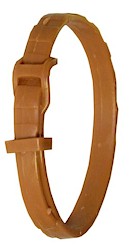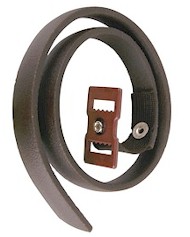Insecticide-impregnated collars are plastic or tissue collars that contain an insecticidal active ingredient and are put to dogs and cats around the neck to protect them against numerous external parasites such as fleas, ticks, mosquitoes, flies, etc.
The active ingredient is mixed with the plastic of the collar before hardening in a mold, or otherwise added to the collar material in such a way that after being applied to the pet it will slowly release the insecticide during weeks and even months.

The insecticide will spread throughout the pet's hair coat to cover most of the pet's body surface. The insecticide can be released by abrasion, diffusion or evaporation due to the pet's body heat.
Depending on the specific features of each active ingredient it will kill, sterilize or repel the parasites.
Some high-tech collars are capable or releasing the active ingredient very regularly ensuring a good control for months. Less sophisticated collars will release most of the active ingredient in the first weeks after application and get quickly exhausted.
Most pet collars are easy and convenient to handle and normally cheaper than spot-on (= squeeze-on = pipettes). Some collars may stink, especially those with certain organophosphates.
Active ingredients used in insecticide-impregnated pet collars/>
Most insecticides, tickicides or acaricides used to impregnate collars are veteran generic active ingredient, mostly synthetic pyrethroids (e.g. deltamethrin, cypermethrin, permethrin), organophosphates (e.g. diazinon, chlorpyrifos, etc.), carbamates (e.g. carbaryl, propoxur) and amidines (mainly amitraz) or neonicotinoids (e.g. imidacloprid). Other collars contain natural insecticides that repel rather than kill some parasites. Some collars carry mixtures of various active ingredients.
Insecticide-impregnated collars have been marketed for more than 40 years. This is why many of them contain veteran insecticides and acaricides. In many countries newer pet flea and tick products such as spot-ons have taken over a good share of the market. One reason may be that efficacy of the veteran active ingredient against fleas is often diminished due to resistance.
There are no insecticide impregnated collars for livestock. The homologous slow-release devices for livestock are the insecticide-impregnated ear-tags that are used against a few fly species (e.g. horn flies).
Parasites controlled by insecticide-impregnated pet collars
Depending on the active ingredients they contain, collars are efficient against fleas, ticks, mites and lice. Some collars protect pets also against mosquitoes, black flies, gnats ( = gnats, = Simuliids), midges (= Culicoides), sandflies and other flying parasites.
No collar protects against internal parasites of pets such as roundworms, tapeworms or flukes.
Efficacy of insecticide-impregnated pet collars

Some collars can protect pets against fleas for up to 12 weeks and more, which is substantially longer than most spot-ons. (= pipettes). But this strongly depends on the specific epidemiological situation and whether or not the fleas are already resistant to the active ingredient.
As a thumb rule, good spot-ons should kill >95% of the fleas within 1 to 2 days after treatment and protect the pets up to 80% against re-infestation, for 3-4 weeks, whereas good collars should kill 80-90% of the fleas within 1 week after application and protect the pets up to 70% against re-infestation for 8 to 12 weeks.
Whether you perceive such an efficacy as "good control" that meets your expectation is another story. Here is why:
- If an infested dog carries 10 fleas and 90% are "controlled", 1 flea may survive. You won't notice it: No fleas, good product!
- In an infested dog carries 100 fleas and 90% are controlled, 10 fleas will survive. You'll notice them: product is rubbish!
- Can a single dog carry 100 fleas? Yes, it can! Not always, not everywhere...
Collars are often a good option for reasonably protecting pets against fleas, ticks and/or other parasites for long periods of time (preventive or prophylactic use), but not the best option for a quick and urgent fix (i.e. within hours) in case of a sudden outbreak.
The persistence of the active ingredient after exposure to water (rain, swimming, etc.), washing or shampooing depends on each specific collar. Rain, shampooing or a splah will not eliminate the active ingredient remaining inside the collar but may wash away the active ingredient that impregnates the pet's hair coat. It will take a few days for freshly active ingredient to be released by the collar and to re-impregnate the pet's hair coat.
Resistance of parasites to insecticide-impregnated pet collars
Resistance of fleas to "veteran" insecticides of chemical classes such as organophosphates, carbamates and synthetic pyrethroids is frequent worldwide. The fact is that most collars contain such veteran insecticides. It is likely that such collars may not work as expected against fleas. However, most pet owners do not have the means to find out whether the fleas that plague their pet are resistant or not.
Consequently, if a collar (or any other type of parasiticidal product) doesn't work and there is no reason to believe that it is due to incorrect administration, the best is to try another product with an active ingredient with a different mode of action, i.e. usually of a different chemical class, because different chemical classes usually have different modes of action.
There are nto yet reports on confirmed resistance o fleas to the newest insecticides used in collars such as imidacloprid.
There are a few reports on resistance of the dog tick (Rhipicephalus sanguineus) to organophosphates and synthetic pyrethroids. But it does not seem to be a widespread problem as it is for fleas.
Safety of insecticide-impregnated collars
Insecticide-impregnated collars are usually safe for pet owners. However, it is better for children to avoid close contact with pets that carry collars impregnated with organophosphates, carbamates or synthetic pyrethroids, which can be toxic and/or irritant for the skin and the eyes.
Usually pets tolerate insecticide-impregnated collars rather well, but be aware that some active ingredients can be safe for dogs, but toxic for cats, notably permethrin (and other synthetic pyrethroids) and amitraz. Consequently, never use on cats insecticide-impregnated collars approved only for dogs!